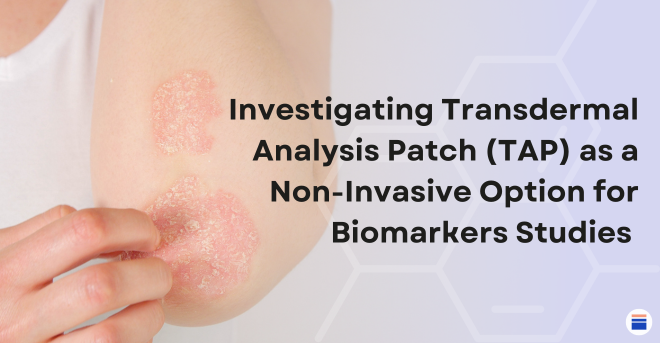Investigating Transdermal Analysis Patch (TAP) as a Non-Invasive Option for Biomarkers Studies

| Table of contents |
| Case 1: pediatric psoriasis study |
| Case 2: atopic dermatitis study |
| Case 3: hidradenitis suppurativa (HS) study |
Conventional avenues to collect samples for the analysis of biomarkers have proven to necessitate intrusive procedures, engendering patient aversion and potential procedural hazards. Several recent non-invasive sampling approaches such as tape stripping and transdermal analysis patch (TAP) are making their way in dermatology clinical trials. This article will focus on TAP in an attempt to bring emphasis on the patient’s well-being and the preservation of the fidelity of acquired data. TAP noninvasively measures soluble proteins in the stratum corne.
Fibrotx is a company based in Estonia which offers TAP technology. This is a microarray that is applied on the skin in small patches which contain antibodies targeting proteins of interest. This company creates patches specific to the needs of a given study. For example, if the study is measuring a certain number of proteins in the skin, they can design patches with antibodies that will be able to bind to those proteins. The patches are hydrated and after a 20-minute application, they are frozen and sent to the company for analysis using SPOT-ELISA to look at the protein level in the skin.
Case 1: pediatric psoriasis study

This study was presented in 2020 at the EADV, it was done on pediatric patients with psoriasis that were between 4 and 18 years old. The TAP was applied on the skin for 20 minutes and the study showed increases in the IL-1RA, hBD-2, and IL-8 in lesional skin as compared to perilesional skin and normal skin.
Case 2: atopic dermatitis study
A second study with a combination of TAP and tape stripping (using D-Squame tape) has been published in 2021. It included 10 patients with atopic dermatitis who were treated with betamethasone dipropionate for 2 weeks. TAP was performed at baseline, day 4, day 8 and day 15. This illustrates one of the advantages, as previously mentioned, of non-invasive approaches such as tape stripping, TAP or other techniques: several analyses can be done within a period of 1 week. This study is quite significant due to the combined techniques of TAP and tape-stripping. The figure below showcases results at baseline. The results have shown statistically significant differences between expression of some biomarkers in lesional and non-lesional skin of patients suffering from atopic dermatitis; there was an increase in several of the known cytokines or chemokines that are increased in atopic dermatitis, including a sharp increase in TARC CCL17 and increases in other cytokines like IL-18 at baseline.
Over time, following treatment with topical corticosteroids, a rapid decrease in some chemokines and cytokines was observed, specifically, a rapid decrease in the CCL22, CCL27 and CCL17. Other cytokines like IL1α did not experience significative changes between baseline and day 14.
Interestingly, the study focused on the level of various cytokines and chemokines, measured by the TAP approach and measured by tape stripping (using D-Squame; CuDerm) and found that there was a high degree of correlation between-tape strips and TAP measured chemokines and cytokines levels. The TAP data for those chemokines and cytokines was in line with the data obtained using the tape stripping approach.
Case 3: hidradenitis suppurativa (HS) study

Finally, this last publication from 2021, used the TAP approach on HS patients. There is a limited amount of information available in the public domain on biomarkers in HS clinical trials, and most available data are from invasive techniques. This study compared 20 patients with HS to 10 healthy controls and TAP was applied on lesional and perilesional skin of axilla and groin in HS subjects and identical sites in healthy controls. Similarly, to the previously discussed studies with psoriasis and atopic dermatitis, the application time was 20 minutes. The central column of the figure below showcases an increase in some chemokines and cytokines specifically IL-1RA, IL-8 (which was highly statistically significant), Hbd-1 and Hbd-2 in lesional skin of HS patients versus healthy controls. Some of those increases have been also reported in skin biopsies. This is one of the few studies that are in the public domain with the use of a non-invasive approach to collect biomarkers in patients with HS and resulted in detecting a signal.
The cases presented in this article demonstrated that non-invasive methods such as TAP can be an interesting path to study biomarkers in clinical trials while propelling patient centricity forward.
About the Author:
Julie’s experience exceeds 10 years in the domains of clinical pharmacology, medical writing, and scientific affairs. This extensive professional journey has been predominantly within the dynamic CRO environment. Julie assumes a pivotal role as medical writer within Innovaderm’s Scientific Affairs Department.
Let’s shape the future of research and make a difference in the industry, gain Innovaderm’s support in your upcoming trial and propel your study to new heights.
Newsletter
Newsletter subscription resources

